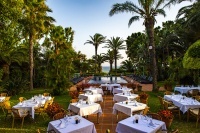 |
| The palm tree-lined Alameda in Tarifa is the pertect spot for lunch and a wander. |
LA ALAMEDA
This is a typical Andalucian tree-lined avenue with bars and restaurants, where the old folk sit on wrought-iron benches in the shade of the vast palms. You will find a number of good restaurants with outside terraces along the east side of the square - the restaurants are actually built into the old city wall and, unusually, have entrances on both sides of the wall.
At the bottom end of the square, nearest the port, is a statue of Tarifa's local hero, Guzman El Bueno - he was a soldier and a nobleman, founder of the Medina Sidonia dynasty.
 |
Tarifa - built in the Moorish style, set in subtropical gardens leading down to the unspoilt beach.
Stylish & contemporary hotel close to unspoilt beaches. Gardens and large pool. Ideal for families.
Next to the Alameda is the old fishing port. To the west, walk down Calle Alcalde Juan Nuñez to the causeway Muelle de Rivera towards Isla de las Palomas. On the causeway you are now at the southern tip of Spain. Punta de Tarifa on the other side of the island is the southerly tip of mainland Spain and mainland Europe (Europe not counting islands and enclaves). The causway to Islas de las Palomas was first established in 1808. It is the most southerly road in mainland Spain and mainland Europe, the Mediterranean Sea and Atlantic Ocean are clearly only a few feet apart. You are 'entre dos aguas' (between two waters) as the iconic flamenco / rumba instrumental by Paco de Lucia goes.
Isla de las Palomas is closed to visitors except for pre-booked guided tours as part of the Parque Natural del Estrecho de Gibraltar. On the island are remains of at least five Phoenician-Punic funeral chambers dated between 6th and 4th century BC. The island was used a limestone quary from Roman times. The fortification of the island was carried out from the seventeenth century when a small millitary battery was established. The military status has protected the island form development. It was handed over to the national coastal agency in 1988 as public domain coastal land. There was a military presence until the end of the 20th century and it was used as a holding point for illegal imigrants arriving from the dangerous crossing across the Strait of Gibraltar from Africa. In 2003 the island and its surrounding waters were further protected by being declared part of the Parque natural del Estrecho de Gibraltar. More>
There are plenty of little tapas bars in the old town, just to the east of the Alameda. To get to this historic area full of atmosphere, inside the city walls, walk through the arch by the Theatre and Tourist Office, or through one of the restaurants.
 |
| The tourist office and municipal theatre are located on the Alameda. |

